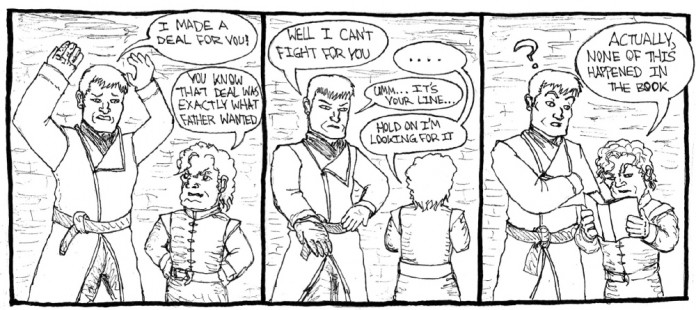Sam Goldman
Staff Writer
Illustration by Hector Lizarraga, Staff Illustrator
Despite its wild popularity, “Game of Thrones” has been increasingly criticized this season by fans who’ve read the series of novels, the complaints being that the show is increasingly diverging from the original books to produce its own stories. While the latest Craster’s Keep incident did leave me scratching my head a little bit, the producers’ adaptations are not something worthy of totally freaking out about.
George R. R. Martin gave David Benioff and D. B. Weiss creative licensing when they agreed to produce the show, meaning the producers could take some liberties with the original work. So they’re obviously not breaking any rules (though maybe some hearts) when we see Arya as Tywin Lannister’s cupbearer. There is, however, an enormous precedent for this: how often does one see a movie or TV show adapted from a book that does not change the story or characters to some degree? “Game of Thrones” is doing the same thing as countless other adaptations. The fans who’ve read the books know what’s supposed to happen–Martin’s 1,770,000 words have already provided them with a vivid mental movie that the show isn’t depriving them of.
Like a book being translated into another language, adaptations between two mediums necessitate changes no matter how faithful to the original producers try to be. Over one and half million words is quite a lot for even a TV show spanning several seasons; there is no way a show meant to keep up more than a sluggish pace can include all the detail and background necessary to reproduce the exact “A Song of Ice and Fire” world. Parts of the story that are boring or rather longwinded and are not totally necessary to continuing the main plots are left out so the show remains manageable.
On top of all that, “A Song of Ice and Fire” is itself a particularly difficult series to adapt to the screen. The many separate storylines may pace themselves evenly in the books, but when the more boring parts of them need to be taken out for the show, storylines become mismatched and require something new to be put in, something that can’t be drawn exactly from the original (i.e., the end of Craster’s Keep). In the same vein, many of the events in the books are so complex and require so much background that they need to be altered so that a simpler plot mechanism that still works with the overall story can be used.
Much of the epic nature and sheer grandness of Martin’s world cannot easily be reproduced for television, whether it’s by physical construction or CGI. Take the Iron Throne, for example: it’s supposed to be made of a good 1,000 swords that can easily cut whoever’s sitting on it and rests imposingly and asymmetrically at the top of a steep set of steps. Both Daenerys’ trip through the House of the Undying and Tyrion’s missing nose are two significant aspects of the books that could not easily be duplicated visually. Moreover, it’s impossible to cast the perfect people (at least from a visual standpoint) for every role, nor is it possible to keep the younger actresses and actors from aging faster than their characters.
All in all, the increasing changes we’re seeing as the story becomes more complex and epic are both necessary and sensible. The great bearded man himself stated in an interview with Vanity Fair that he thinks the show looks great, and that “when you work in television or film, it is a collaborative medium, and you have to allow the other collaborators to bring their own creative impulse to it, too.”
A limit should exist, however, to these kinds of adaptations.
“Game of Thrones” admittedly does go a bit too far sometimes in their amping up of Martin’s more shocking scenes. The show’s creative licensing privileges get put toward playing up parts that contribute to the show’s shock value, which invariably attracts many of its viewers. Gratuitous rape and violence for this purpose–such as the recent, controversial scene of Jaime raping Cersei by Joffrey’s corpse, which was portrayed less coercively in the book–can arguably perpetuate harmful perceptions of these topics, not to mention further confuse an already complicated character arc.
In theory, creative licensing shouldn’t be a problem, but in reality, producers need to take care that what they’re altering isn’t going to unnecessarily depict actions harmful to society’s notions of serious issues. If we’re going to criticize the modifications “Game of Thrones” makes to the books, let’s focus on the ones that matter, rather than the ones that are necessary.










